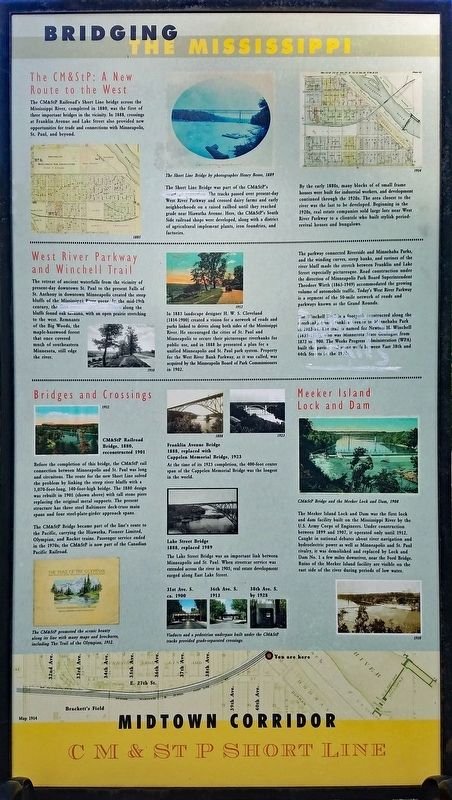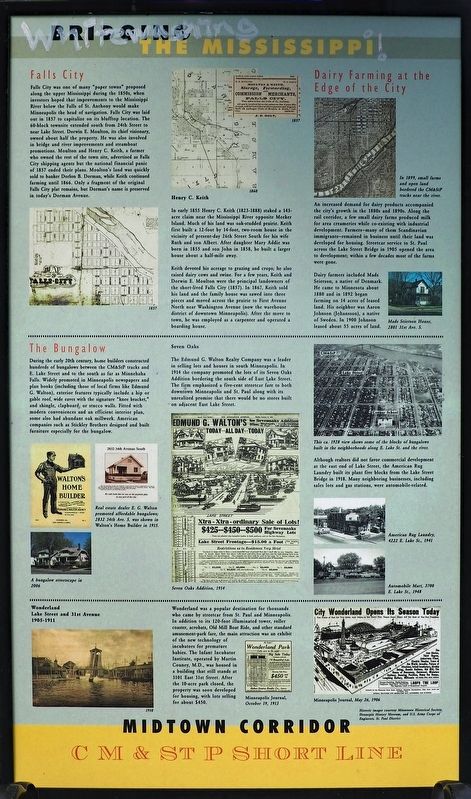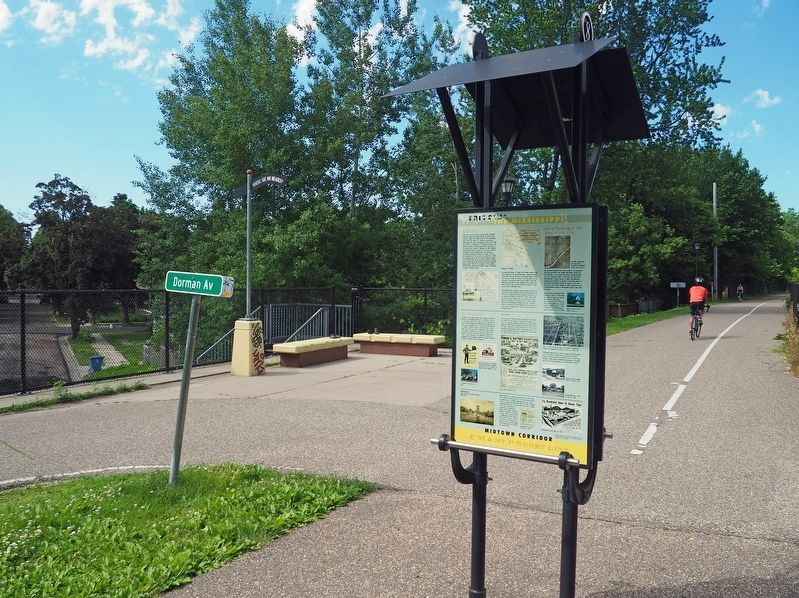Seward in Minneapolis in Hennepin County, Minnesota — The American Midwest (Upper Plains)
Bridging the Mississippi
Midtown Corridor
— C M & St P Short Line —
The CM&StP: A New Route to the West
The CM&StP Railroad's Short Line bridge across the Mississippi River, completed in 1880, was the first of three important bridges in the vicinity. In 1888, crossing at Franklin Avenue and Lake Street also provided new opportunities for trade and connections with Minneapolis, St. Paul, and beyond.
The Short Line Bridge was part of the CM&StP's westward expansion. The tracks passed over present-day West River Parkway and crossed dairy farms and early neighborhoods on a raised railbed until they reached grade near Hiawatha Avenue. Here, the CM&StP's South Side railroad shops were developed, along with a district of agricultural implement plants, iron foundries, and factories.
By the early 1880s, many blocks of of [sic] small frame houses were built for industrial workers, and development continued through the 1920s. The area closest to the river was the last to be developed. Beginning in the 1920s, real estate companies sold large lots near West River Parkway to a clientele who built stylish period-revival houses and bungalows.
West River Parkway and Winchell Trail
The retreat of ancient waterfalls from the vicinity of present-day downtown St. Paul to the present Falls of St. Anthony in downtown Minneapolis created the steep bluffs of the Mississippi River gorge. In the mid-19th century, the first permanent white settlers along the bluffs found oak savanna, with an open prairie stretching to the west. Remnants of the Big Woods, the maple-basswood forest that once covered much of southeastern Minnesota, still edge the river.
In 1883 landscape designer H. W. S. Cleveland (1814-1900) created a vision for a network of roads and parks linked to drives along both sides of the Mississippi River. He encouraged the cities of St. Paul and Minneapolis to secure their picturesque riverbanks for public use, and in 1888 he presented a plan for a unified Minneapolis and St. Paul park system. Property for the West River Bank Parkway, as it was called, was acquired by the Minneapolis Board of Park Commissioners in 1902.
The parkway connected Riverside and Minnehaha Parks, and the winding curves, steep banks, and ravines of the river bluff made the stretch between Franklin and Lake Street especially picturesque. Road constructed under the direction of Minneapolis Park Board Superintendent Theodore Wirth (1863-1949) accommodated the growing volume of automobile traffic. Today's West River Parkway is a segment of the 50-mile network of roads and parkways known as the Grand Rounds.
The Winchell Trail is a footpath constructed along the riverbanks from Franklin Avenue to Minnehaha Park in 1912-14. The trail is named for Newton H. Winchell (1839-1914), who was Minnesota State Geologist from 1872 to 1900. The Works Progress Administration (WPA) built the paving and stone walls between East 38th and 44th Streets in the 1930s.
Bridges and Crossings
CM&StP Railroad Bridge, 1880, reconstructed 1901
Before the completion of this bridge, the CM&StP rail connection between Minneapolis and St. Paul was long and circuitous. The route for the new Short Line solved the problem by linking the steep river bluffs with a 1,070-foot-long, 140-foot-high bridge. The 1880 design was rebuilt in 1901 (shown above) with tall stone piers replacing the original metal supports. The present structure has three steel Baltimore deck-truss main spans and four steel-plate-girder approach spans.
The CM&StP Bridge became part of the line's route to the Pacific, carrying the Hiawatha, Pioneer Limited, Olympian, and Rocket trains. Passenger service ended in the 1970s; the CM&StP is now part of the Canadian Pacific Railroad.
Franklin Avenue Bridge 1888, replaced with Cappelen Memorial Bridge, 1923
At the time of its 1923 completion, the 400-foot center span of the Cappelen Memorial Bridge was the longest in the world.
Lake Street Bridge 1888, replaced 1989
The Lake Street Bridge was an important link between Minneapolis and St. Paul. When streetcar service was extended across the river in 1905, real estate development surged along East Lake Street.
31st Ave. S. ca. 1900
36th Ave. S. 1913
38th Ave. S. by 1928
Viaducts and a pedestrian underpass built under the CM&StP tracks provided grade-separated crossings.
Meeker Island Lock and Dam
The Meeker Island Lock and Dam was the first lock and dam facility built on the Mississippi River by the U.S. Army Corps of Engineers. Under construction between 1899 and 1907, it operated only until 1912. Caught in national debates about river navigation and hydroelectric power as well as Minneapolis and St. Paul rivalry, it was demolished and replaced by Lock and Dam No. 1 a few miles downriver, near the Ford Bridge. Ruins of the Meeker Island facility are visible on the east side of the river during periods of low water.
Reverse side
Falls City
Falls City was one of many "paper towns" proposed along the upper Mississippi during the 1850s, when investors hoped that improvements to the Mississippi River below the Falls of St. Anthony would make Minneapolis the head of navigation. Falls City was laid out in 1857 to capitalize on its blufftop location. The 60-block townsite extended south from 24th Street to near Lake Street. Dorwin E. Moulton, its chief visionary, owned about half the property. He was also involved in bridge and river improvements and steamboat promotions. Moulton and Henry C. Keith, a farmer who owned the rest of the town site, advertised as Falls City shipping agents but the national financial panic of 1857 ended their plans. Moulton's land was quickly sold to banker Dorlon B. Dorman, while Keith continued farming until 1866. Only a fragment of the original Falls City plat remains, but Dorman's name is preserved in today's Dorman Avenue.
Henry C. Keith
In early 1855 Henry C. Keith (1823-1888) staked a 143-acre claim near the Mississippi River opposite Meeker Island. Much of his land was oak-studded prairie. Keith first built a 12-foot by 14-foot, two-room house in the vicinity of present-day 26th Street South for his wife Ruth and son Albert. After daughter Mary Addie was born in 1855 and son John in 1858, he built a larger house about a half-mile away.
Keith devoted his acreage to grazing and crops; he also raised dairy cows and swine. For a few years, Keith and Dorwin E. Moulton were the principal landowners of the short-lived Falls City (1857). In 1867, Keith sold his land and the family house was sawed into three pieces and moved across the prairie to First Avenue North near Washington Avenue (now the warehouse district of downtown Minneapolis). After the move to town, he was employed as a carpenter and operated a boarding house.
An increased demand for dairy products accompanied the city's growth in the 1880s and 1890s. Along the rail corridor, a few small dairy farms produced milk for area creameries while co-existing with industrial development. Farmers–many of them Scandinavian immigrants–remained in business until their land was developed for housing. Streetcar service to St. Paul across the Lake Street Bridge in 1905 opened the area to development; within a few decades most of the farms were gone.
Dairy farmers included Mads Seierson, a native of Denmark. He came to Minnesota about 1880 and in 1892 began farming on 14 acres of leased land. His neighbor was Aaron Johnson (Johansson), a native of Sweden. In 1900 Johnson leased about 55 acres of land.
The Bungalow
During the early 20th century, home builders constructed hundreds of bungalows between the CM&StP tracks and E. Lake Street and to the south as far as Minnehaha Falls. Widely promoted in Minneapolis newspapers and plan books (including those of local firms like Edmund G. Walton), exterior features typically included a hip or gable roof, wide eaves with the signature "knee bracket," and shingle, clapboard, or stucco walls. Fitted with modern conveniences and an efficient interior plan, some also had abundant oak millwork. American companies such as Stickley Brothers designed and built furniture especially for the bungalow.
Seven Oaks
The Edmund G. Walton Realty Company was a leader in selling lots and houses in south Minneapolis. In 1914 the company promoted the lots of its Seven Oaks Addition bordering the south side of East Lake Street. The firm emphasized a five-cent streetcar fare to both downtown Minneapolis and St. Paul along with its unrealized promise that there would be no stores built on adjacent East Lake Street.
Although realtors did not favor commercial development at the east end of Lake Street, the American Rug Laundry built its plan five blocks from the Lake Street Bridge in 1918. Many neighboring businesses, including sales lots and gas stations, were automobile-related.
Wonderland Lake Street and 31st Avenue
1905-1911
Wonderland was a popular destination for thousands who came by streetcar from St. Paul and Minneapolis. In addition to its 120-foot illuminated tower, roller coaster, acrobats, Old Mill Boat Ride, and other standard amusement-park fare, the main attraction was an exhibit of the new technology of incubators for premature babies. The Infant Incubator Institute, operated by Martin County, M.D., was housed in a building that still stands at 3101 East 31st Street. After the 10-acre park closed, the property was soon developed for housing, with lots selling for about $450. (Marker Number 8.)
Topics. This historical marker is listed in these topic lists: Bridges & Viaducts • Parks & Recreational Areas • Railroads & Streetcars.
Location. 44° 57.271′ N, 93° 12.921′ W. Marker is in Minneapolis, Minnesota, in Hennepin County. It is in Seward. Marker can be reached from the intersection of Midtown Greenway and Dorman Avenue. Marker is at the east end of the Midtown Greenway rail trail. It can be accessed by stairs from Dorman Avenue or a ramp from West River Parkway. Touch for map. Marker is in this post office area: Minneapolis MN 55406, United States of America. Touch for directions.
Other nearby markers. At least 8 other markers are within walking distance of this marker. Mississippi River (approx. 0.4 miles away); Meeker Island Lock and Dam (approx. 0.4 miles away); Meeker Island Lock and Dam Historic Site (approx. 0.4 miles away); Roar of Waterfall, Rush of Rapids (approx. half a mile away); Sri Chinmoy Peace Bridge (approx. 0.7 miles away); The Winchell Trail (approx. 0.7 miles away); Wonderland Amusement Park (approx. 0.7 miles away); Sesquicentennial Trees (approx. ¾ mile away). Touch for a list and map of all markers in Minneapolis.
Credits. This page was last revised on February 12, 2023. It was originally submitted on October 21, 2020, by McGhiever of Minneapolis, Minnesota. This page has been viewed 245 times since then and 18 times this year. Last updated on June 22, 2022, by McGhiever of Minneapolis, Minnesota. Photos: 1, 2, 3. submitted on October 21, 2020, by McGhiever of Minneapolis, Minnesota. • J. Makali Bruton was the editor who published this page.


